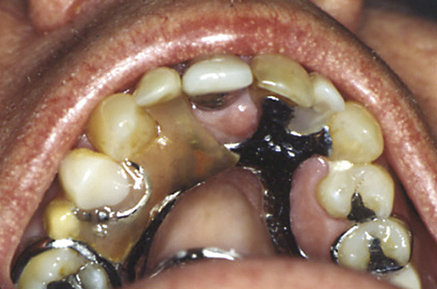Denture-related stomatitis
PREDISPOSING FACTORS
 Dental appliance wearing (mainly maxillary dentures), especially when worn throughout the night, or with a dry mouth, is the major predisposing factor.
Dental appliance wearing (mainly maxillary dentures), especially when worn throughout the night, or with a dry mouth, is the major predisposing factor.
 Smoking occasionally predisposes.
Smoking occasionally predisposes.
 Diabetes or a high carbohydrate diet occasionally predispose.
Diabetes or a high carbohydrate diet occasionally predispose.
 Hyposalivation is a occasionally an underlying factor.
Hyposalivation is a occasionally an underlying factor.
 Haematinic deficiencies are a rare underlying factor.
Haematinic deficiencies are a rare underlying factor.
CLINICAL FEATURES
The characteristic presenting features of denture-related stomatitis are:
 An absence of symptoms. The former term ‘denture sore mouth’ was a misnomer.
An absence of symptoms. The former term ‘denture sore mouth’ was a misnomer.
 Chronic erythema and oedema of the mucosa that contacts the fitting surface of the denture, usually a complete upper denture (the denture-bearing area); the mucosa below lower dentures is rarely involved (Figs 40.1 and 40.2).
Chronic erythema and oedema of the mucosa that contacts the fitting surface of the denture, usually a complete upper denture (the denture-bearing area); the mucosa below lower dentures is rarely involved (Figs 40.1 and 40.2).

CLASSIFICATION
Denture-related stomatitis has been classified into three clinical types (Newton types), increasing in severity (Table 40.1).
Table 40.1
Newton classification of denture-related stomatitis
| Type | Definition | Comment |
| 1 | Localized simple inflammation or a pinpoint hyperaemia | Early lesion usually |
| 2 | Erythematous or generalized simple type presenting as more diffuse erythema involving a part of, or the entire, den/> |
Stay updated, free dental videos. Join our Telegram channel

VIDEdental - Online dental courses
















